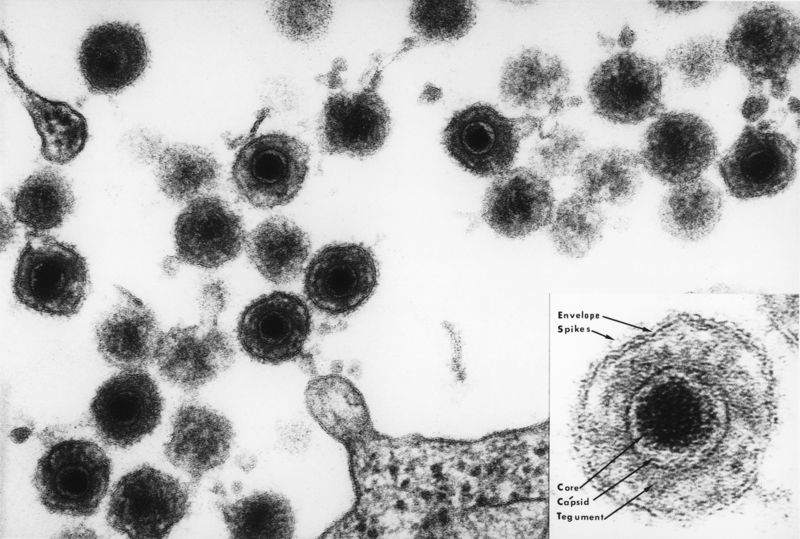Human T-lymphotropic virus
Articles that lack this notice, including many Eduzendium ones, welcome your collaboration! |
Classification
Higher order taxa
Viral Group: Group VI (ssRNA-RT)
Family: Retroviridae
Genus: Deltaretrovirus
Species: Human T-lymphotropic virus
Species
Deltaretrovirus Human T-lymphotropic virus 
Description and significance
Describe the appearance, habitat, etc. of the organism, and why it is important enough to have its genome sequenced. Describe how and where it was isolated. Include a picture or two (with sources) if you can find them.
Human T-lymphotropic virus was first discovered in Japan in 1977 as the first human retrovirus to be identified as such. It is thought to be the disease causing agent in several ailments. Paraparesis is one disease thought to be caused by the virus where an individual's lower extremities are impaired. The virus is also thought to be an oncovirus, a cancer causing viral agent. Leukemia, a cancer of bone marrow or blood cells, has been linked to T-lymphotropic virus.
Genome structure
The virus' genome consists of a single strand of RNA and uses reverse transcription to form DNA from an RNA template. HTLV has a unique genome among retroviruses that highlights its unusual pathogenesis. It has the same gag-pol-env motif, with flanking long terminal repeat sequences (LTR), as all retroviruses. However, it includes a fourth sequence (xP), which participates in open-reading-frame transcription and leads to what are likely pathogenic products: Tax, Rex, p12, p13, and p30.
Describe the size and content of the genome. How many chromosomes? Circular or linear? Other interesting features? What is known about its sequence? Does it have any plasmids? Are they important to the organism's lifestyle?
Cell structure and metabolism
HTLV is an enveloped virus. A core contains the genetic material as well as reverse transcribing proteins that facilitate transcription from RNA to DNA. This core is encased in a protein shell called a capsid. The outer most portion of the virus is the envelope - a phospholipid bilayer derived from the host cell that helps the virus invade a host cell. Between the envelope and the capsid is a collection of proteins called the tegument.
Describe any interesting features and/or cell structures; how it gains energy; what important molecules it produces.
Ecology
HTLV interacts primarily with human hosts. Close relatives of the virus, however, do exist and invade other animal hosts.
Describe any interactions with other organisms (included eukaryotes), contributions to the environment, effect on environment, etc.
Pathology
The virus, once in the host, can cause a variety of disease. These diseases include HTLV-1 associated myelopathy, opportunistic infections from other microbes due to a debilitated immune system, and cancer. Through a unique feedback mechanism involving Tax and Rex that early, rapid replication of the virus is achieved, followed by abrupt inhibition of viral replication. This replication surge and termination sequence allow for dissemination in acute infection, followed by a quiescent phase in which HTLV evades host immune defenses. This places HTLV in the unique category of delta retroviruses, whose only other members are a few nonhuman viruses: BLV, STLV (simian T-cell leukemia virus), and PTLV (primate T-cell leukemia virus).
How does this organism cause disease? Human, animal, plant hosts? Virulence factors, as well as patient symptoms.
Application to Biotechnology
Does this organism produce any useful compounds or enzymes? What are they and how are they used?
Current Research
Human T-lymphotropic virus type I infection. Human T-cell lymphotropic virus type I (HTLV-I) is the first human retrovirus to be associated with malignant disease--namely, adult T-cell leukaemia/lymphoma. HTLV-I has also been associated with several non-malignant conditions, notably the chronic neurodegenerative disorder, HTLV-I associated myelopathy (also known as tropical spastic paraparesis), infective dermatitis of children and uveitis. More recent evidence points to disease associations not previously linked to HTLV-I. Thus, the disease spectrum of HTLV-I is not fully known. HTLV-I has a worldwide distribution with major endemic foci in the Caribbean and southern Japan. The public health importance is confirmed by the major routes of transmission, which are mother-to-child, blood transfusion, and sexual activity. Unfortunately, no vaccine is available yet and there is no proven treatment for advanced HTLV-I disease. http://www.ncbi.nlm.nih.gov/pubmed/10371587
References
1. http://en.wikipedia.org/wiki/Human_T-lymphotropic_virus
2. http://www.medicalnewstoday.com/articles/95706.php
3. http://www.ncbi.nlm.nih.gov/pubmed/